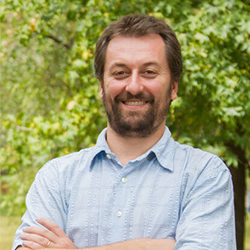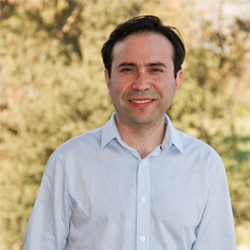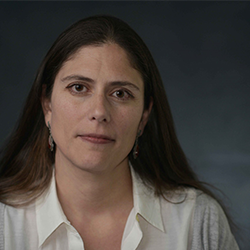Elections Series: Chile Constitutional Assembly

Matias Bargsted

Luis Maldonado

Author: Jaclyn Leaver
On Sunday, May 7, Chilean citizens head to the polls to vote in a constitutional assembly election that will create a new Constitutional Council of 50 members tasked with reviewing and approving a final proposal for a new constitution. We brought together three scholars with expertise in the country to discuss with us this critical moment for Chile:
Matías Bargsted is an associate professor and department chair of the Institute of Sociology, Pontificia Universidad Católica de Chile. He is also an associate researcher at the Center for Social Conflict and Cohesion Studies, where he actively collaborates in the design and application of the Chilean Longitudinal Social Survey. His research interests include public opinion research, comparative political behavior, sociology of religion and quantitative methods.
Luis Maldonado is a professor in the Department of Sociology at the Pontificia Universidad Católica of Chile, with affiliation in the The National Research Center for Integrated Natural Disaster Management (CIGIDEN) and the Center for Social Conflict and Cohesion Studies (COES), Chile. His research interests include economic inequality, disasters and quantitative methods.
Carolina Segovia is a professor in the Department of Political Studies at the Universidad de Santiago of Chile, and a researcher at the Center for Social Conflict and Cohesion Studies (COES). Her research interests include public opinion research, political behavior, affects and emotions in politics.
This is the second attempt at writing a constitution, since the “estallido social” of 2019 precipitated a crisis in government that resulted in Chile overwhelmingly supporting the referendum to draft a new constitution and replace the existing dictatorship-era document. What were some of the issues that caused the failure of the first process (whose resulting draft was ultimately voted down by over 60 percent of Chileans)?
Matias Bargsted, Luis Maldonado: There are three key factors behind the rejection of the constitutional draft. First, the draft, in spatial terms, leaned too far to the left. Accordingly, most voters who are on the right or center or are independents opted to reject the text. The text contained many elements that adopted very progressive stances on issues that are highly controversial among Chilean society, such as pluri-nationality, moral sexuality issues, property rights, and state provisions, among others. Pluri-nationality, in the context of the constitutional convention, implied defining Chile as the aggregate of twelve indigenous nations and of one (rather undefined) non-indigenous nation. This outlook challenged a two-centuries long tradition of state centralization and unitary notion of nationhood. Survey evidence suggests that this was the single most relevant issue defining voter preferences during the September Plebiscite. A second factor was the climate within the Constitutional Council. The Constitutional Convention captured well the widely spread anti-party and anti-establishment climate of opinion that is rooted in Chilean society, and which became dominant during the Chilean burst of 2019. However, the alternative presented by the Convention did not provide an appealing picture of political negotiating and bargaining. Intra-bloc and inter-bloc disputes, many times affectively charged, were very frequent, and Chileans were exposed during an entire year to a picture of constitutional building as a confrontational and adversarial process. Lastly, the Constitutional Convention experienced some reputational wounds that made permanent damage. The most noteworthy, but not only, case refers to the discovery that an elected member of the left-wing populist People’s List (Lista del Pueblo), an aggrupation of independents who obtained an extraordinary electoral performance (26 of the 155 seats), falsely claimed to suffer cancer during his electoral campaign.
Carolina Segovia: In addition, in this referendum, voting was mandatory. Since 2012 Chile has had a system with voluntary voting and an automatic registry. Under this system, around 50 percent of those eligible to vote did so. In the September referendum, 86 percent turned out to vote, increasing the number of voters by around 4 million. Most of these voters have never voted before, raising uncertainty about the result of the election. Research has shown that most new voters voted against the first draft.
As well, the constitution-writing process was evaluated negatively by citizens. On the one hand, discussion at the Constitutional Convention was highly polarized and sometimes banalized. Therefore, the approval of the Constitutional Convention started to fall very soon. On the other hand, the groups within the Convention pushed for issues that didn’t reflect people’s interests or preferences. In some cases, they veered too far from their proposals. The center of the public discussion was on two main issues: the status of indigenous people in the proposed text and the characteristics of the political system.
Further, since President Gabriel Boric began his term (March 2021), the government has pushed and campaigned for the approval of the text. The referendum, therefore, was not only about the new proposed text but also a referendum on Boric’s administration. But the government has faced criticisms, and it has not been able to achieve high approval ratings. The consequences of the COVID-19 pandemic and other economic problems also affected the government’s approval. Voting in the referendum was, in a way, a manifestation of this lack of approval of the president and his government.
How is this second go-around different? What has the government done to try to address the issues that arose in the first draft process?
MB: After citizens voted overwhelmingly to reject the draft, the issues and positions advocated by left-wing groups have lost much appeal. Simultaneously, rising crime rates and deterioration of several economic indicators unleashed an important backlash dynamic that shifted the political scenario towards the right. The current administration of President Gabriel Boric, a former student activist and deputy of the left-wing coalition Frente Amplio, has also seen public opinion support for their agenda of social transformations severely reduced. Consequently, he has progressively replaced left-wing government ministers with people on the center-left (and who come from the former Concertación coalition). Ironically, while the previous right-wing administration of former President Sebastian Piñera passed highly cherished legislation for the left (e.g., same-sex marriage laws), the current left-wing government has recently passed legislation that hardened punishments of felonies committed against police officers and supported the approval of an important free trade agreement.
LM: One of the most important differences between both processes is the role of political parties. An anti-establishment orientation dominated the discussion around the first election, and several social movements played a central role. Their discourse was firmly against the traditional parties and political system. For the new polls, social movements play a minor role, and the organization of the process is in the hands of parties.
Regarding the role of government, it has several strategies. On one hand, the government’s program was explicitly associated with the proposal for the first election, and they paid the costs of the failure. For these second elections, it is essential to distinguish the government from the results of the new process. On the other hand, misinformation about the proposal is a relevant factor for several actors associated with the government, so we can see actions to address this topic. There is indeed currently a public campaign that attacks misinformation about issues relevant to the new constitution.
CS: In fact, the whole constitution-writing process is different. In general terms, the first process can be described as one with few constraints. In the words of the politicians who signed the November 2019 agreement, the process was to start with a “blank page .” After that, everything was possible as long as it had the agreement of two-thirds of the Convention.
The new process is a constrained one: first, the parties in Congress signed on fundamental issues that are not to be challenged by the Council. Second, three bodies are involved in the writing, and the Expert Commission—nominated by Congress—is to produce a first draft. This draft will be voted on and possibly modified by the Council. Third, a Committee on Admissibility will review the text and check whether it is coherent with the fundamental issues defined early on. Finally, Chilean voters will vote on the approval or rejection of the new constitution in a new referendum on December 17.
What body will be elected on May 7th and what role will it play in the Constitutional process?
MB, LM, CS: The election on May 7 is for the members of the Constitutional Council. It is a group of 50 elected constitutional advisors, and they will be tasked with drafting a new constitution. They will begin their work thirty days after its election and must deliver the draft five months later by November 6. A mandatory referendum for the draft will be held on December 17, 2023.
In addition to the Constitutional Council, there is an Expert Commission. It aims to draft a text for the Constitutional Council before it begins its work. They are currently working on a first draft, which began on March 6 and will continue until June 6. The commission consists of 24 commissioners appointed by the Chilean Congress.
Who is running in this election? Have any party coalitions formed, and who is expected to do well and why?
MB: Traditional political parties, particularly those from the center-right, center, and center-left, who were the main targets of the October 2019 movement, are now in a much better position than they were during the election of the previous Constitutional Convention. After the Plebiscite of September, these parties were reinvigorated. During the campaign, right-wing and center parties committed to continue with the constitutional process in case the constitutional proposal was rejected as a way to ensure that they were not against changing the constitution per se, but against the proposed draft in particular. They claimed that Chilean society deserved a constitutional text that was more consensual and less divisive. By holding to their promise, their degree of credibility among the population increased. On the other hand, left wing parties, particularly the Communist Party and the Frente Amplio, have not only received much of the blame for the defeat of September, but were until recently, the dominant force behind the government. Though the erosion of public support for the current administration is not uncommon, as those in power in most countries tend to be blamed for the social malaise and unfulfilled expectations of the public.
LM: There are three coalitions. Unity for Chile (Unidad para Chile) includes parties and organizations from center-left to the left. Everything for Chile (Todo por Chile) regards parties at the center and center-left. The government depends on these two coalitions. Safe Chile (Chile Seguro) represents center-right and right-wing parties. The government has suffered a decrease in its support in public opinion, and the electoral results for coalitions that support the government will suffer the consequences of this erosion.
In addition to this coalition, there are four options: Republican Party (far-right), Pact with the People (center-right to right-wing), lists of independent candidates, and independent candidates outside lists. Campaigns of the Republican Party and Pact with People are aligned with populist tendencies, especially for security and criminality issues, which may increase their chances in this election.
CS: The electoral system used for this election is the same that regulates Chilean Senate elections. It is a moderate-proportional representation system where candidates run for elections in 16 regions. District magnitude varies from 2 to 5 seats, and parties compete in an open-list system. Unfortunately, no public opinion surveys have been published that could provide evidence of the people’s preferences for the election.
Some early polling has indicated that the public may once again reject the final product of this process. What is the current mood around the constitutional process at the moment?
MB: My impression is that Chilean society is experiencing constitutional fatigue. We’ve been discussing constitutional issues since November 2019, and citizen involvement and monitoring of the future Constitutional Council might be low. Moreover, the points mentioned above also imply that during this next attempt there is less at stake; this will, presumably, further temper the intensity of the debates.
LM: I think that voters’ interest is lower than for the first election. Social justice and anti-establishment preferences dominated the public discussion for the first proposal. However, the main issues in public opinion currently regard security and criminality, and both also appear in the debate for the new election. A critical topic now is whether such issues should be included in the new constitution.
CS: I believe it is too soon to know. Surveys have shown a lack of interest in the process. It seems as if people do not want to hear anything else about the constitution, but this might change. It will depend on the Constitutional Council and how the new text is shared and discussed publicly.
What are some of the other main issues that are likely to come up and play a role in this election?
MB: I think there will be a lot of attention on traditional constitutional issues, such as institutional design of the State, coverage of rights and duties, how to secure the autonomy of the judiciary, and how to further decentralize the Chilean state. What might be less expected is that more attention will be paid to “material” issues such as control of crime and social order, enforcement of property rights, regulation of inflation, and budget deficits. I would also expect, given where the ideological pendulum is today, more support for both public and private provision of social services, as opposed to the previous draft that attempted to secure a more privileged role for state provision.
LM: As said above, security and criminality are the main issues. Migration also appears as a topic in public opinion. However, it needs to be clarified if these issues should be included in the new constitution, insofar as they are temporary topics that affect the mood of public opinion today.
CS: The main issues in this election are not constitutional reform. A look at a candidate’s campaign shows a discourse more similar to what you could expect from people running for Congress. The main issues in this campaign are crime, violence, immigration, social security reform, health systems, and housing issues. Not much is shown about what to expect from the parties in constitutional matters. Additionally, some parties have “presidentialized” this campaign, focusing on the role and figure of party leaders. These party leaders are not candidates for the Council, but they are interested in competing for the next presidential election and are using this opportunity to build public support.